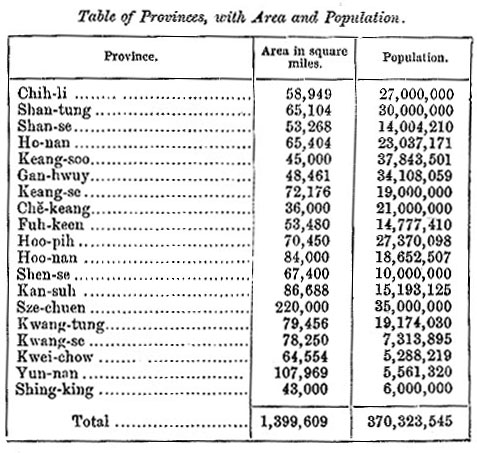1902 Encyclopedia > China > General Description of China Proper. Great Delta Plain.
China
(Part 3)
C. GENERAL DESCRIPTION OF CHINA PROPER
General Description of China Proper. Great Delta Plain
China, as the name is at present used, embraces within its boundaries the dependencies of Manchuria, Mongolia, and Tibet, in addition to China Proper. This vast empire extends from 18° 30´ to 53° 25´ N. lat. and from 80° to 130° E. long. It is bounded on the N. by Asiatic Russia along a frontier extending nearly 3000 miles; on the E. by those portions of the Pacific Ocean which are known in the north as the Sea of Japan, in the central portion as the Yellow Sea, and in the south as the China Sea; on the S. and S.W. by the China Sea, Cochin China, and Burmah; and on the W. by Kashmir and Eastern Turkestan, which province has within the last few years been wrested from China by the Ataligh Ghazee.

Table of Provinces, with Area and Population
The area of China Proper is not more than half that of the whole empire; it extends as far north only as 41° lat., and as far west as 98° long. It is about 1474 miles in length, and its breadth is about 1355 miles. Its coast line measures about 2500 miles; its land frontier is described as being 4400 miles in length, and its area is said to contain 1,399,609 square miles.
Surface.—One of the most noticeable features in the surface of China is the immense delta plain in the north-eastern portion of the empire, which, curving round the mountainous districts of Shan-tung, extends for about 700 miles in a southerly direction from the neighbourhood of Peking, and varies from 150 to 500 miles in breadth. Commencing in the prefecture of Yung-ping Foo, in the province of Chih-li, its outer limit passes in a westerly direction as far as Chang-ping chow, north-west of Peking. Thence running a south-south-westerly course it passes westward of ching-ting Foo and Kwang-ping Foo till it reaches the upper waters of the Wei River in Ho-nan. From this point it turns westward and crosses the Hwang-ho, or Yellow River, in the prefecture of Hwai-king. Leaving this river it takes a course a little to the east of south, and passing west of joo-ning Foo, in the province of Ho-nan, it turns in a more easterly direction as far as Leuchow Foo. From this prefecture an arm of the plain, in which lies the Tsaou Lake, stretches southward from the Hwai River to the Yang-tsze Keang, and trending eastward occupies the region between the river and Hang-chow Bay. To the north of this arm rises a hilly district, in the centre of which stands Nankung.
The boundary of the plain round the mountainous region of Shan-tung begins at lai-chow Foo, and described a huge bow to the west and southward to the frontier of the province of Keang-soo, which boundary it follows to the sea. The greater part of this vast plain descends very gently towards the sea, and is generally below the level of the Yellow River,—hence the disastrous inundations which so often accompany the rise of the Hwang-ho. It is the delta of the Yellow River, and also to some extent of the Yang-tsze Keang, and it is chiefly remarkable for its semi-annular shape, within which it encloses the mountain districts of the province of Shan-tung. Owing to the great quantity of soil which is brought down by the waters of the yellow River, and to the absence of oceanic currents, this delta is rapidly increasing and the adjoining seas are as rapidly becoming shallower. As an instance, it is said that the town of Pootai was 1 le west of the sea-shore, in the year 220 B.C., and in 1730 it was 140 le inland, thus giving a yearly encroachment on the sea of about 100 feet. Again, Seen-shwuy Kow on the Peiho was on the sea-shore in 500 miles A.D., and it is now about 18 miles inland.
Read the rest of this article:
China - Table of Contents
|
